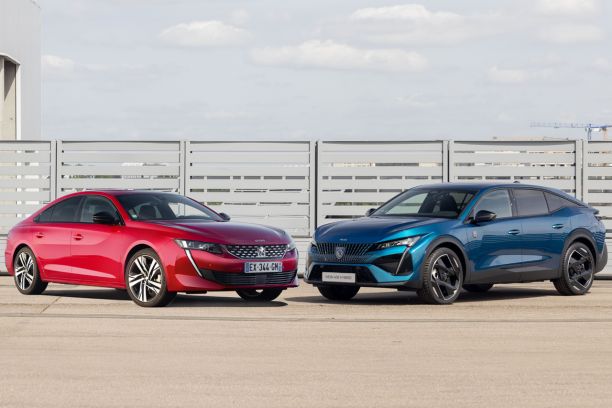
In the reserves of the gendarmerie museum, the Peugeot 405 T16 could easily go unnoticed. But this very wise-looking sedan hid an engine that was both muscular and sophisticated. L’argus presents one of the ten copies used by the rapid intervention brigades.
World Rally Championship, Paris-Dakar, Pikes Peak… in competition, the T16 label is synonymous with many successes for Peugeot. But on the road, he did not have the same success. Born only to ensure homologation in Group B, the 205 T16 “200 series” thus did not exceed the 200 copies imposed by the regulations. As for the 405 T16, it only sold 1,046 units, despite greater commercial ambitions. It is therefore today a real collector … a fortiori when it is hosted by the Mechanical Memory of the museum of the gendarmerie. Our copy of the day is indeed one of ten that operated within the Rapid Intervention Brigades, the famous BRIs, in the 1990s.
The next generation of the Renault 21 Turbo
The Lion sedan took over from another sporty family car, the Renault 21 Turbo. But initially, the police hesitated with another model in the range, much more widespread and more affordable. ““As early as 1989, they tried out the 405 MI16, they had a copy”, explains Jean-Yves Hardouin, referent of the Mechanical Memory of the Musée de la Gendarmerie. “And that wasn’t enough for them, it wasn’t powerful enough, it wasn’t what they were looking for, so they targeted the T16.” “Turbo Garrett with variable geometry then unheard of for a gasoline engine, air-water intercooler, forged rods and pistons… Peugeot had refused nothing to its standard bearer.

The power of the two-liter 16-valve four-cylinder goes from 160 hp on the MI16, devoid of any supercharging, to 200 hp, and torque from a meager 177 Nm to 288 Nm. Values that can even climb even further for 45 seconds to 220 hp and 318 Nm, thanks to an overboost increasing the turbo pressure by 0.2 bars if the intake temperature is not too high.
The Antithesis of the Pikes Peak Monster


This feature is one of the few things in common with the racing 405 T16. Because if the latter was none other than a 205 T16 rearranged, with an engine in the rear central position, the road 405 T16 keeps its mechanics at the front and wants to be extremely civilized. It is enough to look at it to suspect it. Here, no giant aerodynamic appendages like on the Pikes Peak monster. The specific fin remains modest in size, and the rest of the body is shared with the discreet MI16, except for 16-inch rims. Despite its 175 hp “only”, the old BRI R21 Turbo finally seemed more showy.

But when entering the ranks of the gendarmerie, the Lioness is still entitled to a blue dress, a flashing light, a radio antenna and war paint, partially inherited from her predecessor. “It’s the R21 that started to have side stripes all along, all the zebra markings in front and behind, and the 405 logically followed since it comes after”, recalls Jean-Yves Hardouin. Its interior is distinguished by fabric seats borrowed from the MI16 phase 2, instead of those in leather-Alcantara normally supplied.
Second 4×4 model of the BRI


Like the racing version, this registered T16 can also count on four-wheel drive. What offer him an even more imperturbable behavior than on the rest of the range, already renowned in this field. After the R21 Turbo Quadra and long before the Subaru WRX, it is also the second 4×4 model of the BRI. Unfortunately, this standard all-wheel drive will prove to be one of the model’s Achilles heels, the fault of a transfer case deemed to be very fragile, just like the central differential. Very sophisticated, this 405 will also be penalized by excessively high prices. Not to mention a late marketing, in the spring of 1993, when its namesakes have already deserted the competition for a long time. Deprived of direct descendant, it will be replaced in the BRI by a smaller, more compact and less powerful sister, the 306 S16.
Soon a 508 PSE of the gendarmerie?

But in the civil, it can count recently on a distant spiritual heiress: the 508 PSE. A plug-in hybrid family of 360 hp that many would imagine joining the ranks of the gendarmerie soon, all the more so as it would also correspond to the stated desire to “green” the fleet. After the controversy aroused by the arrival of Seat Leon Cupra, it would also allow us to reconnect with the tradition of favoring French models, only broken so far by the Subaru Impreza WRX. It remains to contend with prices even higher than those of its predecessor, a fault even more difficult to accept today than in the 1990s.
The main technical characteristics
- Engine: inline four-cylinder, 1,998 cc, turbo, 16-valve
- Max power : 200 hp from 5,000 to 6,500 rpm / 220 hp with overboost
- Max torque : 288 Nm at 2,600 rpm / 318 Nm with overboost
- Transmission: 4×4, 5 speed
- Weight: 1340 kg
- Dimensions (L x W x H): 4.408 x 1.714 x 1.390 m
- 0 to 100 km / h: 7 s
- Max speed : 235 km / h
- Production: 1,046 copies
The saga of the gendarmerie museum
Do not miss any episode of our saga devoted to the reserves of the Musée de la Gendarmerie. Find all the subjects in photos and videos dedicated to iconic sports models by clicking on the links below:
- The cars of the Gendarmerie museum reserves
- The unusual vehicles of the museum’s reserves
- All about the colors and plates of the gendarmerie
- Rapid Intervention Brigade. Mythical vehicles to discover














